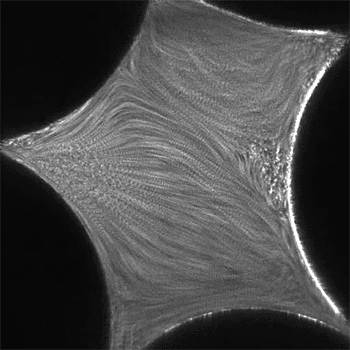Porous Artificial Rock Helps Channel an Answer to a 54-Year-Old Mystery
Why certain fluids strangely slow down under pressure when flowing through porous materials
This feature was provided by Princeton University.
Princeton researchers have solved a 54-year-old puzzle about why certain fluids strangely slow down under pressure when flowing through porous materials, such as soils and sedimentary rocks. The findings could help improve important processes in energy, environmental, and industrial sectors from oil recovery to groundwater cleanup.
The fluids in question are called polymer solutions. These solutions—examples of which include cosmetic creams and nasal mucus—contain dissolved polymers, or materials made of large molecules with many repeating subunits. Typically, polymer solutions become less viscous and flow faster under pressure. But when going through materials with tiny holes and channels, the solutions become more viscous and gunky, reducing their flow rates.

Video showing the movement of a polymer solution inside a pore due to a flow imposed from left to right. Bright streaks show the motion of small tracer particles; dark circles at the periphery show the 0.3 mm-diameter solid grains comprising the solid matrix. At this higher flow rate, polymers cause the fluid motion to become chaotic, with swirling eddies that form, grow, move, and disappear, as well as considerable fluid mixing. Credit: Christopher Browne and Sujit Datta, Princeton University
To tackle the problem, the Princeton researchers used a see-through porous medium made of tiny glass beads—a transparent artificial rock. This lucid medium allowed the researchers to analyze a polymer solution’s movement as it passed through the channels.
"We finally made it possible to see exactly what is happening underground," said Christopher Browne, a PhD student and the paper’s lead author, who will present the work in a scientific talk during the 74th Annual Meeting of the APS Division of Fluid Dynamics.
The analysis overturned the assumption that tiny channels create uniform laminar flow in polymer solutions. Instead, the polymers stretched out, creating turbulence in the flow and substantially slowing its velocity.
"Surprisingly, until now, it has not been possible to predict the viscosity of polymer solutions flowing in porous media," said Sujit Datta, an Assistant Professor of Chemical and Biological Engineering at Princeton and senior author of a new study appearing in the journal Science Advances. "But in this paper, we've now finally shown these predictions can be made, so we've found an answer to a problem that has eluded researchers for over a half-century."
Elastic Turbulence Generates Anomalous Flow Resistance in Porous Media
8:00 a.m. - 8:13 a.m. MST, Monday, November 22, 2021
Contact: Christopher A. Browne, Princeton University
